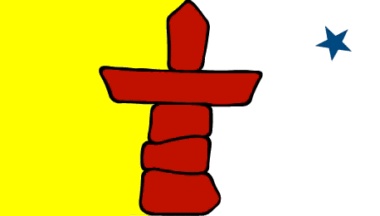|
|
|
Nunavut |
 |
|
The LandOn April 1, 1999, the map of Canada changed with the birth of the new territory of Nunavut.Nunavut means "our land" in Inuktitut, the Inuit language. It is a vast territory - larger than Newfoundland, Prince Edward Island, Nova Scotia, New Brunswick and Quebec combined - that contains one fifth of Canada's land. This is the first major change to the map of Canada since Newfoundland joined Canada in 1949. Nunavut's lands are made up of the central and eastern portions of the Northwest Territories (NWT). To the Inuit people, this land, their ancestral home for thousands of years, has always been Nunavut. The idea for the territory with its own government was articulated by Inuit leaders in the 1970s. The HistoryAs the newest partner in the federation, Nunavut is the latest development in Canada's nation building. All Canadians can take pride in the outstanding achievement the birth of the new territory represents. Canada has redrawn its map peacefully, democratically and in partnership.The creation of Nunavut also marks a profound shift in how Canada relates to Aboriginal peoples. Inuit, as the majority population of Nunavut, are shaping the territorial government in keeping with their culture, traditions and aspirations. The Government of Nunavut is elected by all residents of the territory regardless of their origin. All citizens have the right to vote and run for office. Jobs in the Government of Nunavut's public service are open to all 28 000 residents. The Government of Nunavut provides services in English, French and Inuktitut. The government intends to incorporate the best of traditional Inuit and contemporary government systems. Respect for its citizens' diversity is an essential element of Canada's nation-building process. The creation of Nunavut demonstrates that Canada can adapt its governance to respect the values and traditions of Aboriginal peoples. Over the millennia, Inuit have adapted successfully to one of the harshest climates on earth. Blending this tradition with modern technology and government organization will be the hallmark of the new government. Nunavut brings a distinctive voice to national policy and direction. It is helping to make Canadians more aware of the challenges of day-to-day life in this vast territory. The Government of Nunavut is highly decentralized, the better to respond to the needs of its 26 far-flung communities. State-of-the-art communications technology plays a crucial role in this decentralized structure. The EconomyThe settlement of the Nunavut land claim and the creation of the territory of Nunavut provide a solid and stable environment for future economic development in this picturesque and resource rich region. The clear delineation of land ownership and the establishment of the territorial government will bring about the following:
The Government of Nunavut faces enormous challenges, not the least of which is to re-establish self-sufficiency for future generations. About 56 percent of Nunavut's residents are under the age of 25. The government must work to create employment opportunities, increase education and income levels, and cope with a cost of living two to three times higher than that of southern Canada. The creation of Nunavut restores to Inuit their self-determination as practised for thousands of years before the arrival of Europeans. The new government puts Inuit of Nunavut on an equal footing with other Canadians in terms of having control over and being accountable for their social and economic well-being. |
|
Back |
|
| Source: Communication Canada | |
| Related sites: Government of Nunavut Nunavut.com |
|
|
|
|
| Top Home |